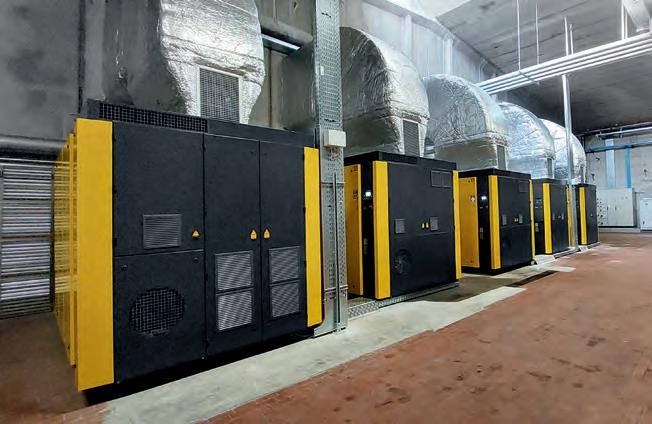
4 minute read
An Italian family history
For textile manufacturers wishing to reduce their operating costs and environmental impact, energy efficiency is every bit as essential a priority as it is in other industries. The use of compressed air for processes in the textiles sector provides a valuable opportunity to improve energy efficiency. With this in mind, Italian producer Cervotessile S.p.a. recently invested in refurbishment of the compressed air station at its production facility in the northern town of Bogogno.
The story of family-owned textiles manufacturer Cervotessile goes back to 1815, when company founder Gaspare Sironi began to have the yarn that he had lovingly selected himself handwoven into quality fabrics, and in doing so laid the groundwork for what was to become a highly successful industrial-scale operation.
Towards the end of the nineteenth century the handlooms began to disappear, replaced by the earliest mechanical looms, which could be used to produce high-value textiles and lining materials. Subsequent generations of the family introduced their own important innovations and improvements, thereby building success through a shared family vision sustained over the course of many decades.
Today the company trades worldwide under the name of Cervotessile S.p.a. Rich in a traditional history that marks it out from its competitors, it is renowned for manufacturing responsible, high-quality products that are permeated with Italian handweaving heritage, combining excellence and harmony, research and development, usability and beauty.
Cervotessile has perfected the ancient art of textiles whilst at the same time refining production technology and enhancing sustainability throughout the entire value chain. This approach consists of, for example, selecting sustainable and fairly produced raw materials, employing low-emissions production processes and using highly energy-efficient systems.
Compressed air under the spotlight
In keeping with this approach, the compressed air station at Bogogno recently underwent an in-depth review. Compressed air plays an important role in textiles manufacturing, since it is used to power the weaving machines. This makes dependability an absolute must – as is the energy efficiency of the complete system.
For the first step towards refurbishing the system, an ADA (Air Demand Analysis) was conducted in order to determine customer-specific variables such as air flow, system pressure and energy consumption: data that are essential for designing the perfect compressed air station. Next, KESS (Kaeser Energy Saving System) software was used to simulate different design options using the customer’s individual consumption profile and thereby to identify the perfect solution.
The result was a realistic virtual working scenario that provided the basis for calculating the dimensions necessary to select the optimal components for the station. These comprehensive analyses and simulations produced an air station comprising five KAESER machines: two type DSD 240 (rated power 132 kW) and three type DSDX 305 (rated power 160 kW) rotary screw compressors, one of which is equipped with a frequency converter.
Of course, in addition to generation, treatment is a vital element of a dependable compressed air supply. In this case it is provided by four SECOTEC TG 960 refrigeration dryers and four KS 700 coalescence filters. What is more, the treatment components are protected by the KAESER-developed DHS 4.0 electronic air-main charging system, which reliably guarantees compressed air quality in accordance with ISO 8573-1. As with all other components in the system, the DHS 4.0 is connected to a SIGMA AIR MANAGER 4.0 master controller, which controls and monitors the station in real time, thereby ensuring best possible energy efficiency and enormous, wide-ranging energy savings.

Objective achieved
Refurbishment of the compressed air station has brought with it significant advantages: distribution of the overall capacity amongst multiple machines has introduced greater flexibility and the ability to react more effectively to fluctuations in production. Moreover, the high technical standard of the station has reduced damaging emissions on a number of levels. For example, lower electricity consumption has reduced CO2 emissions, whilst the heat recovery system that reuses the energy from compression has decreased the amount of gas required for heating purposes, leading to fewer climate-damaging emissions.
A cost-benefit analysis reveals that the modernisation programme has resulted in an increase in efficiency of around 25 percent, which represents an advantage for the operator not only in terms of the associated cost reduction, but also because this makes the company eligible for GSE certificates. These tradeable securities are energy-efficiency certificates issued by the Italian energy services operator Gestore dei Servizi Energetici.








